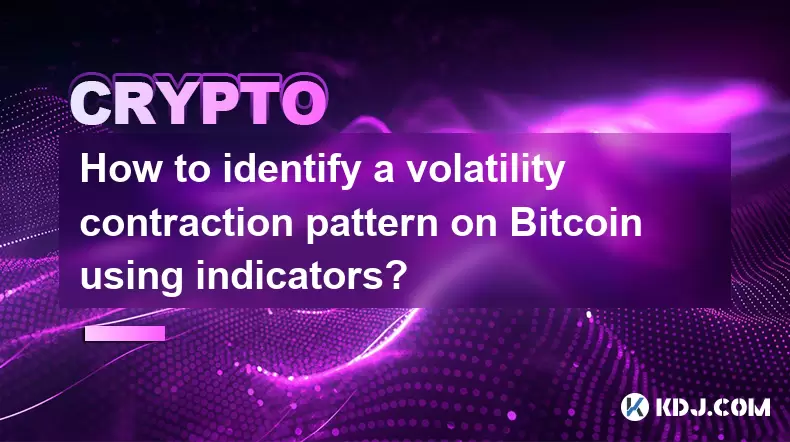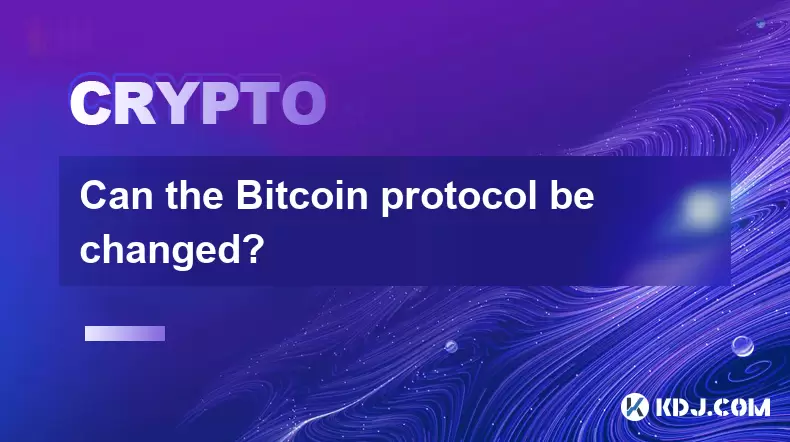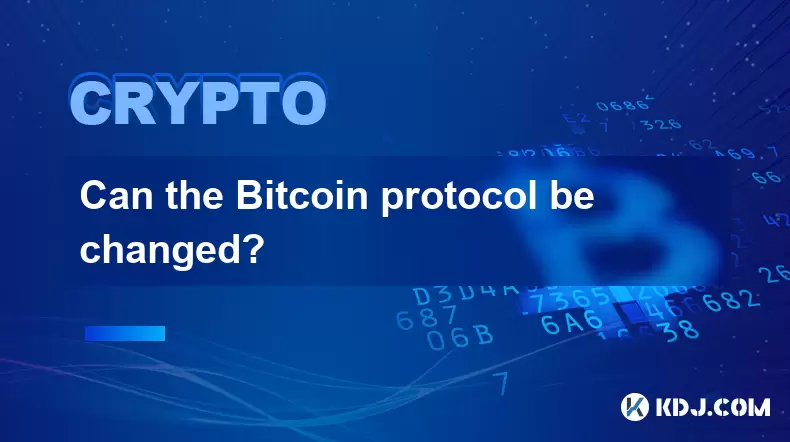-
 bitcoin
bitcoin $122090.672462 USD
1.59% -
 ethereum
ethereum $4493.758974 USD
0.56% -
 xrp
xrp $3.033145 USD
0.65% -
 tether
tether $1.000629 USD
0.00% -
 bnb
bnb $1169.854250 USD
7.07% -
 solana
solana $230.954786 USD
-0.19% -
 usd-coin
usd-coin $0.999785 USD
0.00% -
 dogecoin
dogecoin $0.256108 USD
-1.12% -
 tron
tron $0.342333 USD
-0.12% -
 cardano
cardano $0.859632 USD
-0.10% -
 hyperliquid
hyperliquid $48.932146 USD
-2.25% -
 chainlink
chainlink $22.345466 USD
-1.29% -
 ethena-usde
ethena-usde $1.000217 USD
-0.03% -
 avalanche
avalanche $31.203456 USD
1.93% -
 sui
sui $3.579145 USD
1.05%
How to identify a volatility contraction pattern on Bitcoin using indicators?
Bitcoin's volatility contraction patterns signal potential breakouts, identified using tools like Bollinger Bands, ATR, and Donchian Channels.
Jul 07, 2025 at 07:28 am

What is a Volatility Contraction Pattern in Bitcoin Trading?
A volatility contraction pattern refers to a phase where the price movement of an asset, such as Bitcoin, becomes increasingly narrow over time. This typically signals that the market is consolidating and may be preparing for a breakout or breakdown. In simpler terms, when volatility contracts, it means that the range between highs and lows shrinks significantly. Traders look for this pattern because it often precedes a significant price move.
This phenomenon can occur during periods of low trading volume or uncertainty among investors. Identifying this pattern early allows traders to anticipate potential breakouts before they happen, giving them a strategic advantage in entering trades.
Key Indicators Used to Identify Volatility Contraction
To detect a volatility contraction pattern in Bitcoin, traders rely on specific technical indicators that measure price volatility and range compression. The most commonly used tools include:
- Bollinger Bands: These bands adjust dynamically based on standard deviations of price. When the bands begin to narrow, it indicates a decrease in volatility.
- Average True Range (ATR): ATR measures market volatility by analyzing the range of price movements. A declining ATR value suggests contracting volatility.
- Donchian Channels: These channels plot the highest high and lowest low over a set period. Narrowing channels indicate consolidation.
- Moving Averages: While not direct volatility indicators, moving averages help identify trends and can signal when a breakout might occur after a contraction phase.
Each of these indicators plays a crucial role in confirming the presence of a volatility contraction pattern and should be used together for more accurate analysis.
Using Bollinger Bands to Detect Price Compression
One of the most effective ways to spot a volatility contraction in Bitcoin is through Bollinger Bands. These bands consist of a middle band, which is a simple moving average, and two outer bands that represent standard deviations above and below the middle line.
When the distance between the upper and lower bands begins to shrink, it visually demonstrates that volatility is decreasing. This narrowing is often referred to as a 'squeeze.' During a squeeze, prices tend to trade within a tight range, signaling that a sharp move could be imminent.
Traders often wait for the price to break out of the bands after a prolonged contraction to confirm the direction of the next move. Combining Bollinger Bands with volume indicators like On-Balance Volume (OBV) can further enhance the accuracy of these signals.
Analyzing Average True Range (ATR) for Volatility Changes
The Average True Range (ATR) is another powerful tool for identifying volatility contraction patterns in Bitcoin. ATR calculates the average range of price movement over a defined number of periods, typically 14.
As volatility decreases, the ATR value will also decline. A flattening or downward trend in the ATR line suggests that price swings are becoming smaller, indicating a possible consolidation phase. This contraction often precedes a strong directional move.
To apply ATR effectively, traders monitor its value alongside price action. If the ATR is falling while the price remains range-bound, it reinforces the likelihood of an upcoming breakout. Some traders use a threshold or percentage change in ATR to trigger alerts for potential volatility expansions.
Interpreting Donchian Channels in Bitcoin Volatility Patterns
Donchian Channels provide a clear visual representation of price ranges over a given period—usually 20 days. They consist of three lines: the highest high, the lowest low, and the midline.
In a volatility contraction scenario, the upper and lower bands of the channel will draw closer together, indicating that the price is compressing within a tighter range. This narrowing is a sign of reduced momentum and often precedes a breakout.
Traders watch for the price to close outside the upper or lower band as confirmation of a new trend. When combined with other tools like Bollinger Bands and ATR, Donchian Channels offer a robust framework for detecting and acting upon volatility contraction patterns in Bitcoin.
Practical Steps to Confirm a Volatility Contraction Pattern
To practically identify a volatility contraction pattern in Bitcoin, follow these steps:
- Overlay Bollinger Bands on the chart and observe if the bands are tightening.
- Add the ATR indicator and check for a declining trend in values.
- Plot Donchian Channels to see if the upper and lower bounds are narrowing.
- Analyze price action to ensure it is indeed consolidating and not trending.
- Use volume indicators like OBV to confirm whether participation is decreasing during the contraction phase.
Once all these conditions align, it becomes highly probable that a volatility contraction is occurring. At this stage, traders typically prepare for a breakout by setting entry orders just beyond the current range boundaries.
Frequently Asked Questions (FAQ)
Q: Can I solely rely on Bollinger Bands to identify volatility contraction in Bitcoin?While Bollinger Bands are useful, relying solely on them may lead to false signals. It’s best to combine them with other indicators like ATR and volume metrics for better accuracy.
Q: How long does a typical volatility contraction phase last in Bitcoin markets?There is no fixed duration, but most contractions last anywhere from a few hours to several days depending on the timeframe being analyzed. Shorter timeframes may show quicker setups, while longer ones take more time to develop.
Q: Is a volatility contraction always followed by a breakout in Bitcoin?Not necessarily. Sometimes the contraction continues without a significant move, especially in sideways markets. It's important to wait for confirmation before entering a trade.
Q: Do all cryptocurrencies exhibit volatility contraction patterns similar to Bitcoin?Most cryptocurrencies do experience volatility contractions, but their frequency and intensity may vary due to differences in liquidity, market cap, and investor sentiment.
Disclaimer:info@kdj.com
The information provided is not trading advice. kdj.com does not assume any responsibility for any investments made based on the information provided in this article. Cryptocurrencies are highly volatile and it is highly recommended that you invest with caution after thorough research!
If you believe that the content used on this website infringes your copyright, please contact us immediately (info@kdj.com) and we will delete it promptly.
- BlockDAG, DOGE, HYPE Sponsorship: Crypto Trends Shaping 2025
- 2025-10-01 00:25:13
- Deutsche Börse and Circle: A StableCoin Adoption Powerhouse in Europe
- 2025-10-01 00:25:13
- BlockDAG's Presale Buzz: Is It the Crypto to Watch in October 2025?
- 2025-10-01 00:30:13
- Bitcoin, Crypto, and IQ: When Genius Meets Digital Gold?
- 2025-10-01 00:30:13
- Stablecoins, American Innovation, and Wallet Tokens: The Next Frontier
- 2025-10-01 00:35:12
- NBU, Coins, and Crypto in Ukraine: A New Yorker's Take
- 2025-10-01 00:45:14
Related knowledge

Why is Bitcoin considered a revolutionary technology?
Aug 12,2025 at 08:29pm
Decentralization and the Elimination of Central AuthoritiesThe core innovation behind Bitcoin lies in its decentralized architecture, which fundamenta...

Why is Bitcoin considered a revolutionary technology?
Aug 10,2025 at 07:42pm
Decentralized Architecture and Trustless TransactionsBitcoin is considered revolutionary because it introduced a decentralized architecture that opera...

What are the key features of Bitcoin?
Aug 10,2025 at 02:50am
Decentralization and Peer-to-Peer NetworkOne of the most defining characteristics of Bitcoin is its decentralized nature. Unlike traditional financial...

Can the Bitcoin protocol be changed?
Aug 07,2025 at 01:16pm
Understanding the Bitcoin ProtocolThe Bitcoin protocol is the foundational set of rules that govern how the Bitcoin network operates. It defines every...

Can the Bitcoin protocol be changed?
Aug 11,2025 at 01:01am
Understanding the Bitcoin Protocol StructureThe Bitcoin protocol is the foundational set of rules that govern how the Bitcoin network operates. These ...

What happens to Bitcoin transactions once they are confirmed?
Aug 09,2025 at 05:22am
Understanding Bitcoin Transaction ConfirmationWhen a Bitcoin transaction is initiated, it is broadcast to the network and placed in a pool of unconfir...

Why is Bitcoin considered a revolutionary technology?
Aug 12,2025 at 08:29pm
Decentralization and the Elimination of Central AuthoritiesThe core innovation behind Bitcoin lies in its decentralized architecture, which fundamenta...

Why is Bitcoin considered a revolutionary technology?
Aug 10,2025 at 07:42pm
Decentralized Architecture and Trustless TransactionsBitcoin is considered revolutionary because it introduced a decentralized architecture that opera...

What are the key features of Bitcoin?
Aug 10,2025 at 02:50am
Decentralization and Peer-to-Peer NetworkOne of the most defining characteristics of Bitcoin is its decentralized nature. Unlike traditional financial...

Can the Bitcoin protocol be changed?
Aug 07,2025 at 01:16pm
Understanding the Bitcoin ProtocolThe Bitcoin protocol is the foundational set of rules that govern how the Bitcoin network operates. It defines every...

Can the Bitcoin protocol be changed?
Aug 11,2025 at 01:01am
Understanding the Bitcoin Protocol StructureThe Bitcoin protocol is the foundational set of rules that govern how the Bitcoin network operates. These ...

What happens to Bitcoin transactions once they are confirmed?
Aug 09,2025 at 05:22am
Understanding Bitcoin Transaction ConfirmationWhen a Bitcoin transaction is initiated, it is broadcast to the network and placed in a pool of unconfir...
See all articles










































































